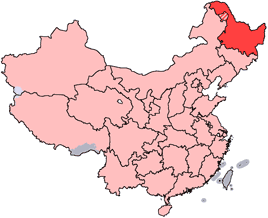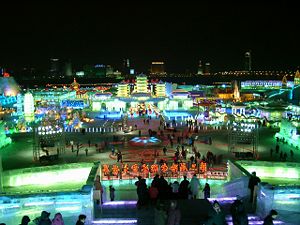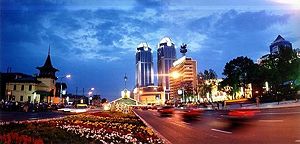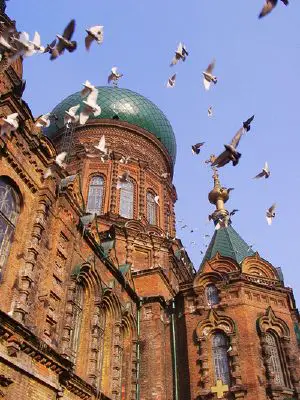Difference between revisions of "Heilongjiang" - New World Encyclopedia
Nim Ruparel (talk | contribs) |
Nim Ruparel (talk | contribs) |
||
| Line 41: | Line 41: | ||
{{History of the Amur region}} | {{History of the Amur region}} | ||
| − | In ancient times Heilongjiang was far from any literate civilization, and information was sparse. [[China|Chinese]] and other sources state that Heilongjiang was inhabited by people such as the [[Xianbei]], the [[Mohe]], and the [[Khitan people|Khitan]]. The eastern portion of Heilongjiang was ruled by the kingdom of [[Balhae|Bohai]] between the [[7th century]] and [[10th century]]. The [[Jurchen]] [[Jin Dynasty (1115-1234)]] that subsequently ruled much of | + | In ancient times, Heilongjiang was far from any literate civilization, and information was sparse. [[China|Chinese]] and other sources state that Heilongjiang was inhabited by people such as the [[Xianbei]], the [[Mohe]], and the [[Khitan people|Khitan]]. The eastern portion of Heilongjiang was ruled by the kingdom of [[Balhae|Bohai]] between the [[7th century]] and [[10th century]]. The [[Jurchen]] [[Jin Dynasty (1115-1234)]] that subsequently ruled much of northern China arose within the borders of modern Heilongjiang. |
| − | Under the [[Manchu]] [[Qing Dynasty]], the western part of Heilongjiang was under the supervision of the General of Heilongjiang, whose power extended, according to the [[Treaty of Nerchinsk]], as far north as the [[Stanovoy Mountains]] | + | Under the [[Manchu]] [[Qing Dynasty]], the western part of Heilongjiang was under the supervision of the General of Heilongjiang, whose power extended, according to the [[Treaty of Nerchinsk]], as far north as the [[Stanovoy Mountains]]. Eastern Heilongjiang was under the supervision of the General of Jilin, whose power reached the [[Sea of Japan]]. These areas deep in [[Manchuria]] were closed off to [[Han Chinese]] migration. |
| − | However, in [[1858]] and [[1860]] the [[Qing Dynasty|Qing]] government gave up all land beyond the [[Amur]] and [[Ussuri River|Ussuri]] Rivers to [[Russia]], cutting China off from the [[Sea of Japan]] and giving Heilongjiang its present northern borders. At the same time, [[Manchuria]] was opened to [[Han Chinese]] migration by the [[Qing Dynasty|Qing]] government. By the early [[20th century|twentieth century]], the [[Han Chinese]] had become the dominant ethnic group in the region. In [[1932]], present-day Heilongjiang became part of the [[Japan]] | + | However, in [[1858]] and [[1860]], the [[Qing Dynasty|Qing]] government gave up all land beyond the [[Amur]] and [[Ussuri River|Ussuri]] Rivers to [[Russia]], cutting China off from the [[Sea of Japan]] and giving Heilongjiang its present northern borders. At the same time, [[Manchuria]] was opened to [[Han Chinese|Han]] migration by the [[Qing Dynasty|Qing]] government. By the early [[20th century|twentieth century]], the [[Han Chinese]] had become the dominant ethnic group in the region. In [[1932]], present-day Heilongjiang became part of the [[Japan|Japanese]] [[puppet state]] of [[Manchukuo]]. |
| − | After the [[Japan]] | + | After the [[Japan|Japanese]] defeat in [[1945]], [[Soviet Union|Soviet]] forces entered [[Manchuria]] and gave the [[CCP|Chinese communists]] control over most of the area. Heilongjiang became the first province to be completely controlled by the [[CCP|Chinese communists]] and [[Harbin]] became the first major city under their control. From Manchuria, the communists were able to conduct the initial phases of the [[Chinese Civil War]]. |
| − | At the beginning of communist rule, Heilongjiang province included only the western portion of the present-day province, and had its capital at [[Qiqihar]]. The remaining area was the [[Songjiang Province|province of Songjiang]]; its capital was [[Harbin]]. In [[1954]], these two provinces were merged into present-day Heilongjiang. During the [[Cultural Revolution]] Heilongjiang was also expanded to include [[Hulunbuir League]] and some other areas previously in [[Inner Mongolia]] | + | At the beginning of communist rule, Heilongjiang province included only the western portion of the present-day province, and had its capital at [[Qiqihar]]. The remaining area was considered part of the [[Songjiang Province|province of Songjiang]]; its capital was [[Harbin]]. In [[1954]], these two provinces were merged into present-day Heilongjiang. During the [[Cultural Revolution]], Heilongjiang was also expanded to include [[Hulunbuir League]] and some other areas previously in [[Inner Mongolia]], but most of these changes were reversed later on. |
==Geography== | ==Geography== | ||
| − | Heilongjiang is a land of varied topography. Much of the province is dominated by mountain ranges such as the [[Greater Khingan]] Range and [[Lesser Khingan]] Range, [[Zhangguangcai Mountains]], [[Laoye Mountains]], and [[Wanda Mountains]]. The highest peak is [[Mount Datudingzi]] at 1690 [[Metre|m]] (5545 [[foot (unit of length)|ft]]), located on the border with [[Jilin]] province | + | Heilongjiang is a land of varied topography. Much of the province is dominated by mountain ranges such as the [[Greater Khingan]] Range and [[Lesser Khingan]] Range, [[Zhangguangcai Mountains]], [[Laoye Mountains]], and [[Wanda Mountains]]. The highest peak is [[Mount Datudingzi]] at 1690 [[Metre|m]] (5545 [[foot (unit of length)|ft]]), located on the border with [[Jilin]] province. The Greater Khingan Range contains China's largest remaining virgin forest and is an important area for China's forestry industry. |
[[Image:Ice_Snow_World.jpg|thumb|300px|Winter night in [[Harbin]]'s [[Ice and Snow World]].]] | [[Image:Ice_Snow_World.jpg|thumb|300px|Winter night in [[Harbin]]'s [[Ice and Snow World]].]] | ||
| Line 58: | Line 58: | ||
Heilongjiang is subarctic in [[climate]]. Winters are long and frigid, with an average of −31 to −15[[Celsius|°C]] in January, and summers are short and cool with an average of 18 to 23°C in July. The annual average rainfall is 500 to 600 [[Millimeter|mm]], concentrated mostly in [[summer]]. | Heilongjiang is subarctic in [[climate]]. Winters are long and frigid, with an average of −31 to −15[[Celsius|°C]] in January, and summers are short and cool with an average of 18 to 23°C in July. The annual average rainfall is 500 to 600 [[Millimeter|mm]], concentrated mostly in [[summer]]. | ||
| + | |||
| + | Major Rivers and Lakes: | ||
| + | *[[Amur River]] | ||
| + | *[[Mudan River]] | ||
| + | *[[Songhua River]] | ||
| + | *[[Nen River]] | ||
| + | *[[Xingkai Lake]] | ||
Major Cities: | Major Cities: | ||
| Line 95: | Line 102: | ||
The [[agriculture]] of Heilongjiang, heavily defined by its cold climate, is based upon crops such as [[soybean]]s, [[maize]], and [[wheat]]. Commercial crops grown include [[beet]]s, [[flax]], and [[sunflower]]s. | The [[agriculture]] of Heilongjiang, heavily defined by its cold climate, is based upon crops such as [[soybean]]s, [[maize]], and [[wheat]]. Commercial crops grown include [[beet]]s, [[flax]], and [[sunflower]]s. | ||
| − | Heilongjiang is also an important source of [[lumber]] for China. [[Pine]], especially | + | Heilongjiang is also an important source of [[lumber]] for China. [[Pine]], especially [[Korean pine]] and [[larch]] are the most important forms of lumber produced in the province. Forests are mostly found in the [[Daxingan Mountains]] and [[Xiaoxingan Mountains]], which are also home to protected animal species such as the [[Siberian Tiger]], the [[red-crowned crane]], and the [[lynx]]. |
[[Image:Harbinblue.jpg|thumb|300px|[[Harbin]].]] | [[Image:Harbinblue.jpg|thumb|300px|[[Harbin]].]] | ||
Herding in Heilongjiang is centered upon [[horse]] and [[cattle]]. Heilongjiang has the greatest number of milk cows and the highest production of [[milk]] among all the province-level divisions of China. | Herding in Heilongjiang is centered upon [[horse]] and [[cattle]]. Heilongjiang has the greatest number of milk cows and the highest production of [[milk]] among all the province-level divisions of China. | ||
| − | [[Petroleum]] is of great importance in Heilongjiang, | + | [[Petroleum]] is also of great importance in Heilongjiang, with the [[Daqing oilfields]] serving as an important source of [[petroleum|oil]] for China. Several other important minerals are also found in Heilongjiang, including [[coal]], [[gold]], and [[graphite]]. In addition, Heilongjiang also has great potential for [[wind power]], with an average wind energy density of 200 [[watt]]s per [[square metre]]. |
| − | Heilongjiang is part of [[northeast China]] (Manchuria), the traditional base of [[industry]] for the [[People's Republic of China]]. Industry is focused upon [[coal]], [[petroleum]], [[lumber]], [[machinery]], and [[food]]. Due to its location, Heilongjiang is also an important gateway for [[trade]] with [[Russia]]. In recent years | + | Heilongjiang is part of [[northeast China]] (Manchuria), the traditional base of [[industry]] for the [[People's Republic of China]]. Industry is focused upon [[coal]], [[petroleum]], [[lumber]], [[machinery]], and [[food]]. Due to its location, Heilongjiang is also an important gateway for [[trade]] with [[Russia]]. In recent years however, Manchuria has suffered from stagnation. As a result, the government has started the [[Revitalize Northeast China]] campaign to deal with this problem, using [[privatization]] as the preferred method of [[Chinese economic reform|economic reform]]. |
In 2005, Heilongjiang's nominal GDP was 551 billion yuan (US$68.87 billion), an annual growth rate of 11.6%. Its per capita GDP was 14,430 yuan (US$1,762). Heilongjiang's primary, secondary, and tertiary industries were worth 67.25 billion yuan, 297.08 billion yuan, and 186.67 billion yuan respectively [http://english.peopledaily.com.cn/200601/31/eng20060131_239452.html]. The per capita [[disposable income]] of urban residents in Heilongjiang reached 8,273 yuan (over US$1,000), a rise of 10.7% from the previous year. The per capita net income of rural residents in the province surged 7.2% year-on-year to 3,221 yuan (US$400). [http://english.peopledaily.com.cn/200601/31/eng20060131_239474.html] | In 2005, Heilongjiang's nominal GDP was 551 billion yuan (US$68.87 billion), an annual growth rate of 11.6%. Its per capita GDP was 14,430 yuan (US$1,762). Heilongjiang's primary, secondary, and tertiary industries were worth 67.25 billion yuan, 297.08 billion yuan, and 186.67 billion yuan respectively [http://english.peopledaily.com.cn/200601/31/eng20060131_239452.html]. The per capita [[disposable income]] of urban residents in Heilongjiang reached 8,273 yuan (over US$1,000), a rise of 10.7% from the previous year. The per capita net income of rural residents in the province surged 7.2% year-on-year to 3,221 yuan (US$400). [http://english.peopledaily.com.cn/200601/31/eng20060131_239474.html] | ||
Revision as of 00:06, 21 September 2007
| 黑龙江省 Hēilóngjiāng Shěng | |
| Abbreviations: 黑 (Pinyin: Hēi) | |

| |
| Origin of name | 黑 hēi - black 龙 lóng - dragon 江 jiāng - river "Amur River" |
| Administration type | Province |
| Capital (and largest city) |
Harbin |
| CPC Ctte Secretary | Qian Yunlu |
| Governor | Zhang Zuoji |
| Area | 460,000 km² (6th) |
| Population (2004) - Density |
38,170,000 (16th) 83/km² (26th) |
| GDP (2004) - per capita |
CNY 530.3 billion (13th) CNY 13,900 (10th) |
| HDI (2005) | 0.786 (medium) (8th) |
| Major nationalities | Han - 95% Manchu - 3% Korean - 1% Mongol - 0.4% Hui - 0.3% |
| Prefecture-level | 13 divisions |
| County-level | 128 divisions |
| Township-level† | 1284 divisions |
| ISO 3166-2 | CN-23 |
| Official website http://www.hlj.gov.cn (Simplified Chinese) | |
| Source for population and GDP data: 《中国统计年鉴—2005》 China Statistical Yearbook 2005 Source for nationalities data:ISBN 7503747382 《2000年人口普查中国民族人口资料》 Tabulation on nationalities of 2000 population census of China † As at December 31, 2004
ISBN 7105054255 | |
Heilongjiang ▶ (Simplified Chinese: 黑龙江省; Traditional Chinese: 黑龍江省; pinyin: Hēilóngjiāng; Postal map spelling: Heilungkiang; Manchu: Sahaliyan ula) is a province of the People's Republic of China located in the northeastern part of the country. "Heilongjiang" literally means Black Dragon River, which is the Chinese name for the Amur. The one-character abbreviation is 黑 (pinyin: Hēi). The Manchu name of the region is Sahaliyan ula (literally meaning "Black river"), from which the name of Sakhalin island is derived. Heilongjiang borders Jilin to the south and Inner Mongolia to the west, and it also borders Russia to the north, with the Amur River marking the territorial border between the two countries. Heilongjiang contains China's northernmost point (in Mohe County along the Amur) and easternmost point (at the junction of the Amur and Ussuri Rivers).
History
Template:History of the Amur region
In ancient times, Heilongjiang was far from any literate civilization, and information was sparse. Chinese and other sources state that Heilongjiang was inhabited by people such as the Xianbei, the Mohe, and the Khitan. The eastern portion of Heilongjiang was ruled by the kingdom of Bohai between the 7th century and 10th century. The Jurchen Jin Dynasty (1115-1234) that subsequently ruled much of northern China arose within the borders of modern Heilongjiang.
Under the Manchu Qing Dynasty, the western part of Heilongjiang was under the supervision of the General of Heilongjiang, whose power extended, according to the Treaty of Nerchinsk, as far north as the Stanovoy Mountains. Eastern Heilongjiang was under the supervision of the General of Jilin, whose power reached the Sea of Japan. These areas deep in Manchuria were closed off to Han Chinese migration.
However, in 1858 and 1860, the Qing government gave up all land beyond the Amur and Ussuri Rivers to Russia, cutting China off from the Sea of Japan and giving Heilongjiang its present northern borders. At the same time, Manchuria was opened to Han migration by the Qing government. By the early twentieth century, the Han Chinese had become the dominant ethnic group in the region. In 1932, present-day Heilongjiang became part of the Japanese puppet state of Manchukuo.
After the Japanese defeat in 1945, Soviet forces entered Manchuria and gave the Chinese communists control over most of the area. Heilongjiang became the first province to be completely controlled by the Chinese communists and Harbin became the first major city under their control. From Manchuria, the communists were able to conduct the initial phases of the Chinese Civil War.
At the beginning of communist rule, Heilongjiang province included only the western portion of the present-day province, and had its capital at Qiqihar. The remaining area was considered part of the province of Songjiang; its capital was Harbin. In 1954, these two provinces were merged into present-day Heilongjiang. During the Cultural Revolution, Heilongjiang was also expanded to include Hulunbuir League and some other areas previously in Inner Mongolia, but most of these changes were reversed later on.
Geography
Heilongjiang is a land of varied topography. Much of the province is dominated by mountain ranges such as the Greater Khingan Range and Lesser Khingan Range, Zhangguangcai Mountains, Laoye Mountains, and Wanda Mountains. The highest peak is Mount Datudingzi at 1690 m (5545 ft), located on the border with Jilin province. The Greater Khingan Range contains China's largest remaining virgin forest and is an important area for China's forestry industry.
The interior of the province, which is relatively flat and low in altitude, contains the Songhua River, the Nen River, and the Mudan River, all tributaries of the Amur, while the northern border forms part of the Amur valley. Xingkai Lake (or Khanka Lake) is found on the border with Russia's Primorsky Krai.
Heilongjiang is subarctic in climate. Winters are long and frigid, with an average of −31 to −15°C in January, and summers are short and cool with an average of 18 to 23°C in July. The annual average rainfall is 500 to 600 mm, concentrated mostly in summer.
Major Rivers and Lakes:
- Amur River
- Mudan River
- Songhua River
- Nen River
- Xingkai Lake
Major Cities:
- Harbin
- Qiqihar
- Mudanjiang
- Jiamusi
- Yichun
- Daqing
- Heihe
- Shuangyashan
Administrative divisions
Heilongjiang is divided into thirteen prefecture-level divisions, consisting of twelve prefecture-level cities and one prefecture:
- Harbin (Simplified Chinese: 哈尔滨市, Hanyu Pinyin: Hā'ěrbīn shì)
- Qiqihar (齐齐哈尔市 Qíqíhā'ěr shì)
- Hegang (鹤岗市 Hègǎng shì)
- Shuangyashan (双鸭山市 Shuāngyāshān shì)
- Jixi (鸡西市 Jīxī shì)
- Daqing (大庆市 Dàqìng shì)
- Yichun (伊春市 Yīchūn shì)
- Mudanjiang (牡丹江市 Mǔdānjiāng shì)
- Jiamusi (佳木斯市 Jiāmùsī shì)
- Qitaihe (七台河市 Qītáihé shì)
- Heihe (黑河市 Hēihé shì)
- Suihua (绥化市 Suíhuà shì)
- Daxing'anling Prefecture (大兴安岭地区 Dàxīng'ānlǐng Dìqū)
(About this last prefecture there is information to find at the section Greater Khingan)
The thirteen prefecture-level divisions of Heilongjiang are subdivided into 130 county-level divisions (65 districts, nineteen county-level cities, forty-five counties, and one autonomous county). Those are in turn divided into 1284 township-level divisions (473 towns, 400 townships, 58 ethnic townships, and 353 subdistricts).
See List of administrative divisions of Heilongjiang for a complete list of county-level divisions.
Economy
The agriculture of Heilongjiang, heavily defined by its cold climate, is based upon crops such as soybeans, maize, and wheat. Commercial crops grown include beets, flax, and sunflowers.
Heilongjiang is also an important source of lumber for China. Pine, especially Korean pine and larch are the most important forms of lumber produced in the province. Forests are mostly found in the Daxingan Mountains and Xiaoxingan Mountains, which are also home to protected animal species such as the Siberian Tiger, the red-crowned crane, and the lynx.
Herding in Heilongjiang is centered upon horse and cattle. Heilongjiang has the greatest number of milk cows and the highest production of milk among all the province-level divisions of China.
Petroleum is also of great importance in Heilongjiang, with the Daqing oilfields serving as an important source of oil for China. Several other important minerals are also found in Heilongjiang, including coal, gold, and graphite. In addition, Heilongjiang also has great potential for wind power, with an average wind energy density of 200 watts per square metre.
Heilongjiang is part of northeast China (Manchuria), the traditional base of industry for the People's Republic of China. Industry is focused upon coal, petroleum, lumber, machinery, and food. Due to its location, Heilongjiang is also an important gateway for trade with Russia. In recent years however, Manchuria has suffered from stagnation. As a result, the government has started the Revitalize Northeast China campaign to deal with this problem, using privatization as the preferred method of economic reform.
In 2005, Heilongjiang's nominal GDP was 551 billion yuan (US$68.87 billion), an annual growth rate of 11.6%. Its per capita GDP was 14,430 yuan (US$1,762). Heilongjiang's primary, secondary, and tertiary industries were worth 67.25 billion yuan, 297.08 billion yuan, and 186.67 billion yuan respectively [1]. The per capita disposable income of urban residents in Heilongjiang reached 8,273 yuan (over US$1,000), a rise of 10.7% from the previous year. The per capita net income of rural residents in the province surged 7.2% year-on-year to 3,221 yuan (US$400). [2]
Demographics
The majority of Heilongjiang's population is Han Chinese, while other ethnic minorities include the Manchus, Koreans, Mongols, Hui, Daur, Xibe, Oroqin, Hezhen and Russians.
| Ethnic groups in Heilongjiang, 2000 census | ||
|---|---|---|
| Nationality | Population | Percentage |
| Han Chinese | 34,465,039 | 95.20% |
| Manchu | 1,037,080 | 2.86% |
| Koreans | 388,458 | 1.07% |
| Mongol | 141,495 | 0.39% |
| Hui | 124,003 | 0.34% |
| Daur | 43,608 | 0.12% |
| Xibe | 8,886 | 0.03% |
- Excludes members of the People's Liberation Army in active service.
Culture
Heilongjiang's culture is part of a culture of Northeast China that is relatively homogeneous across all northeastern China (see Culture of Manchuria).
Media
Heilongjiang Television and Harbin Economy Radio serve as broadcasters.
Tourism
Harbin, the provincial capital, is a city of contrasts, with Chinese, Russian, and eclectic worldwide influences clearly apparent. Eastern Orthodox, Roman Catholic, and Protestant churches dot the city.
The long, cold winter is the backdrop for its famed ice sculpture exhibitions. In 2007 already the 8th Ice and Snow World opened to visitors in Harbin. More than 2000 ice sculptures were on display at the annual event. [3]
Wudalianchi Lakes are a series of five lakes formed between 1719 and 1721 when volcanic eruption shaped one section of a tributary of the Amur into five interconnected lakes. The second lake in particular is renowned for its irregular geological sights.
Jingbo Lake, found in Ning'an County, is a section of the Mudan river that has been narrowed and shaped by volcanic eruption into a series of sights, including the Diaoshuilou Falls.
Miscellaneous topics
Colleges and universities
- Heilongjiang University
- Harbin Institute of Technology
Sports
- Asia League Ice Hockey
External links
- Map of Heilongjiang Retrieved September 20, 2007.
- The Provincial Government of Heilongjiang Retrieved September 20, 2007.
- Overview of Heilongjiang Retrieved September 20, 2007.
- UNESCAP Retrieved September 20, 2007.
- People's Daily Retrieved September 20, 2007.
| Province-level divisions administered by the People's Republic of China (PRC) | |
|---|---|
| Provinces | Anhui · Fujian · Gansu · Guangdong · Guizhou · Hainan · Hebei · Heilongjiang · Henan · Hubei · Hunan · Jiangsu · Jiangxi · Jilin · Liaoning · Qinghai · Shaanxi · Shandong · Shanxi · Sichuan · Taiwan · Yunnan · Zhejiang |
| Autonomous regions | Guangxi · Inner Mongolia · Ningxia · Tibet (Xizang) · Xinjiang |
| Municipalities | Beijing · Chongqing · Shanghai · Tianjin |
| Special administrative regions | Hong Kong · Macau |
Template:Heilongjiang
Credits
New World Encyclopedia writers and editors rewrote and completed the Wikipedia article in accordance with New World Encyclopedia standards. This article abides by terms of the Creative Commons CC-by-sa 3.0 License (CC-by-sa), which may be used and disseminated with proper attribution. Credit is due under the terms of this license that can reference both the New World Encyclopedia contributors and the selfless volunteer contributors of the Wikimedia Foundation. To cite this article click here for a list of acceptable citing formats.The history of earlier contributions by wikipedians is accessible to researchers here:
The history of this article since it was imported to New World Encyclopedia:
Note: Some restrictions may apply to use of individual images which are separately licensed.
- ↑ Department of Population, Social, Science and Technology Statistics of the National Bureau of Statistics of China (国家统计局人口和社会科技统计司) and Department of Economic Development of the State Ethnic Affairs Commission of China (国家民族事务委员会经济发展司), eds. Tabulation on Nationalities of 2000 Population Census of China (《2000年人口普查中国民族人口资料》). 2 vols. Beijing: Nationalities Publishing House (民族出版社), 2003. (ISBN 7-105-05425-5)



